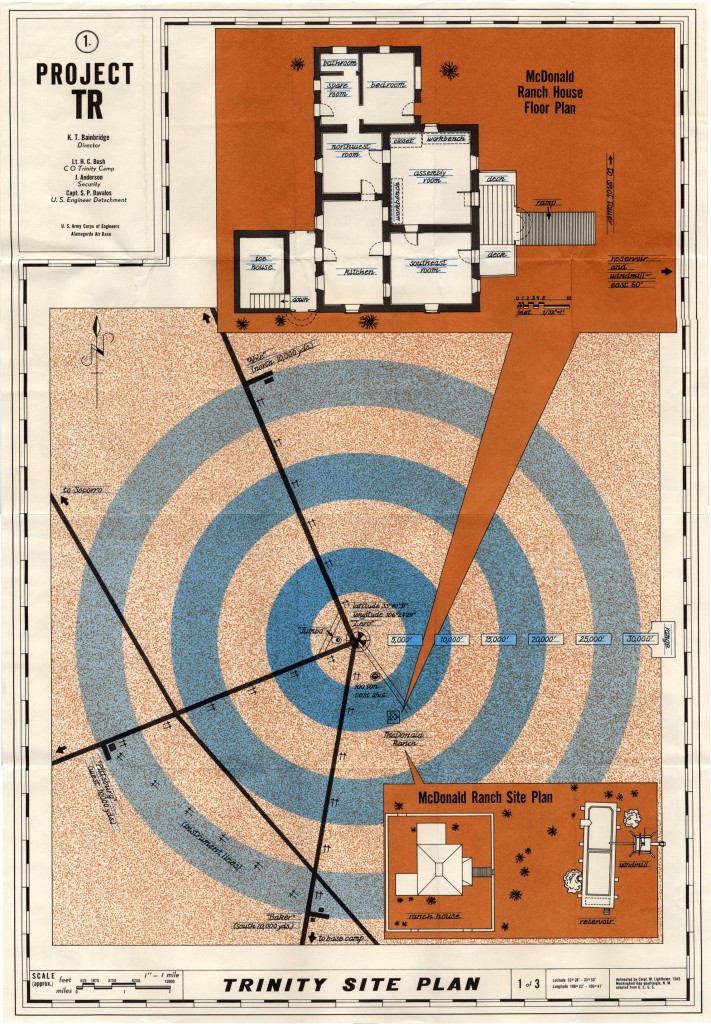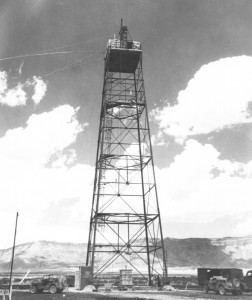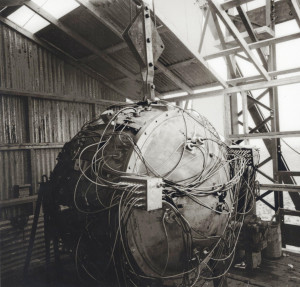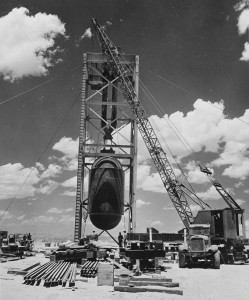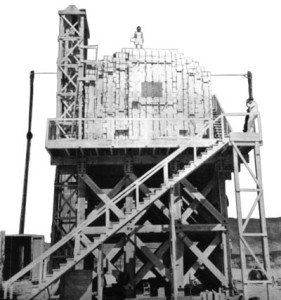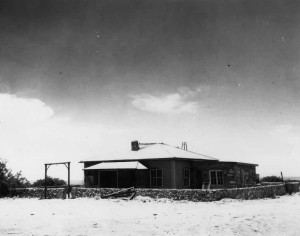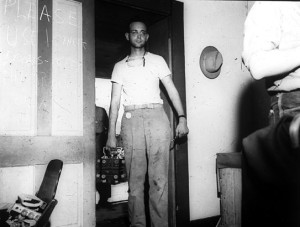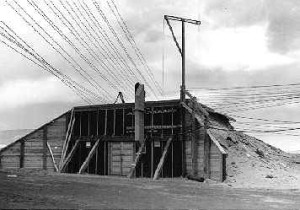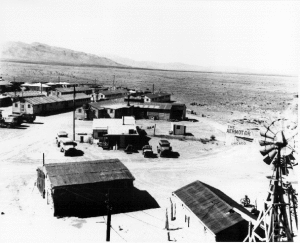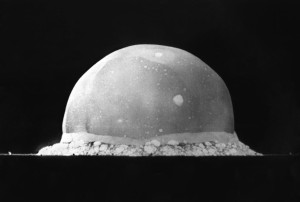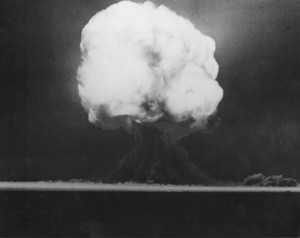We’re interdimensional travelers of time and space, Wabewalkers on the go. We’re going to visit a nondescript spot way out in the New Mexico desert between Socorro and Alamogordo, approximately latitude 33 degrees north, longitude 106 degrees west, late in the evening of July 15, 1945.
If you were a novelist scripting a place to unleash an elemental force of nature, you hardly could have done better than the place we stand now. There’s something different about New Mexico; not for nothing do they call it the Land of Enchantment. It’s a quality of the air, of the light, of the harsh, otherworldly landscape itself which is in no way conventionally beautiful but beautiful all the same. New Mexico captures dreamers for reasons no one can fully articulate. Dreamers like Georgia O’Keeffe, who fled her circle of New York City sophisticates to roam the desert alone and obsessively paint, paint, paint not just the stuff around her but the light that baked her skin brown as a nut. Dreamers like D.H. Lawrence, who wandered to New Mexico as part of his “savage exile” from Britain and stayed long enough to write several books here; he declared New Mexico “the greatest experience I ever had,” one that “changed me forever.”
I know what he meant. When I was young and at loose ends, I took a solitary road trip around the state in my old 280Z, staying at hostels at night and roaming the dunes during the day. I still remember the dust and the sweat and the light, and how good a beer and a dive into a watering hole felt at the end of the day. New Mexico still calls to me. I’ve gone back several times with various companions since, and I suspect I’ll continue to look for excuses to do so for the rest of my life. Still, it’s never been quite the same as it was that first time. I think the desert is best experienced alone.
The part of the desert we’re visiting today was once part of El Camino Real de Tierra Adentro — “The Royal Road of the Interior” — that ran all the way from Mexico City to San Juan Pueblo near the northern border of the present-day state of New Mexico. This stretch of the Camino Real was and is known as Jornada del Muerto — “Journey of the Dead.” It’s so-called because this basin, stretching 100 miles north to south, is bereft of food and water throughout its length. Only yucca and scattered scrub grows here. Native Americans knew from time immemorial to avoid it at all costs, while the Spaniards who died trying to make their way across it became the source of the ominous name it has held since before 1700. The Spaniards named the town they built at its northern tip Socorro — “succor” or “sustenance” — because that’s exactly what it represented to weary travelers from El Paso del Norte heading north toward Santa Fe. Various settlers over the centuries have tried to make a go of life in the Jornada del Muerto, digging wells and bringing in sheep and cattle; we’ll meet in a bit a part of what they left behind. But it’s always a hardscrabble existence, their numbers always few.
This particular night in the Jornada del Muerto is an unusual one for two reasons. First of all, it’s raining, something that happens very seldom here. In fact, it’s raining hard, a violent thunderstorm of the sort that visits the desert only once or so per year. The storm will dump four inches of rain in a few hours onto a region that normally only gets about eight per year. That the rain gods should choose this of all nights to have their frolic seems poetically portentous. Because, you see, perched incongruously in the middle of nothing is a 100-foot-tall tower, Ground Zero of a new era in human history.
Base of Tower
A steel tower rises overhead, black against the cloudy sky. Your eyes follow the tapered frame up the ladder, past dangling ropes and cables, to the platform at its summit.
Paved roads and instrument lines lead off into the surrounding desert.
Let’s travel up the tower’s length and peek inside the flimsy metal shed perched at its top (what barrier is height to an interdimensional traveler?). Inside we see the “gadget,” the world’s first atomic bomb, an ungainly contraption of steel and cabling. We’ve arrived at Trinity.
Shack
You're in a metal shack, barely twelve feet square. The oak floor is littered with discarded bits of rope, pulleys and other hardware. A dark light bulb hangs from the ceiling. You can see an exit in the west wall.
A five-foot sphere rests on a bracket in the middle of the floor. Its surface is studded with bolts and crossed with electrical cables, all converging in a boxlike enclosure nearby.
Sitting in the corner (luckily, we interdimensional travelers are also invisible) is a young man flipping nervously through a cheap paperback. His name is Donald Hornig, and he’s 25 years old. He’s a prodigious chemist who’s already earned his PhD, an expert on explosives who was plucked out of the Woods Hole Oceanographic Institute by James Conant, President of Harvard, to join the Manhattan Project. He did important work on the implosion process that will, if all goes well, start in a matter of a few hours a nuclear chain reaction in the gadget with which he now shares the shed. He will go on to a long career as a professor and administrator in some of the pinnacles of academia: Brown, Princeton, Harvard.
Right now, however, Hornig is just a glorified babysitter, perched up here because General Leslie Groves and Robert Oppenheimer are paranoid about sabotage and don’t trust any ordinary guard to get too close to the gadget. He must know at some level that, brilliant as he is, he’s no Oppenheimer or Edward Teller; he’s up here at the top of a 100-foot tower babysitting a cobbled-together nuclear bomb in the middle of a violent thunderstorm because he’s expendable. That’s the way it always is; when the Oppenheimers and Groves of the world start their grand projects, there always have to be lots of Hornigs to see that they get done. He tries to forget his predicament, tries to read his book — The Desert Island Decameron, a collection of light essays and stories written by popular authors and sold cheap to keep the troops entertained — under the light of the single bare bulb dangling from the ceiling, trying to ignore the flashing lightning and howling wind. At last, at midnight, with the storm still raging, the telephone rings: “Come down!” Hornig climbs carefully down the side of the tower, then gets into a jeep and heads off to the canteen at the base camp for a cup of coffee. He will be the last person to see the gadget.
As the hours pass and the bomb sits alone up there in its shed, the temporary bunkers and camps that surround it are buzzing with activity. The plan was to explode the gadget at 4:00 this morning, but the weather causes a delay and much uncertainty. It’s considered urgently important to do the test this morning if at all possible, as President Truman is now in Potsdam and awaiting word of the Manhattan Project’s success — or failure — to know how he should conduct himself with Soviet General Secretary Stalin; as a whole raft of dignitaries and representatives have made the trip down to New Mexico to see the blast; as everyone is so damn tired — most of the people working onsite haven’t slept for two days — that they’d need a week or two just to rest and recuperate and prepare everything again for a rescheduled test.
Thankfully, the rain stops at dawn.
At 5:10, a physicist named Samuel King Allison begins intoning the final twenty-minute countdown over loudspeakers mounted all over the complex. His voice booms out for our ears only from the base of the tower itself. Countdowns sounding much like this one will later become familiar to everyone who watches the NASA space launches on television. This one, though, is like the gadget itself the first of its kind in the history of the world. A local radio station is broadcasting on a similar wavelength; Allison’s dulcet tones are occasionally overlaid with snatches of The Nutcracker Suite. Indeed, radio interference has been a constant problem at the Trinity site. The frequency chosen for short-wave communication among the scientists is the same as that used by a railway freight yard in San Antonio, Texas. Throughout the last weeks of frenzied preparation, the scientists could sometimes hear the train dispatchers — and the train dispatchers could presumably sometimes hear the scientists. Even more alarmingly for security, Trinity also occasionally gets its bandwidth crossed with shortwave transmissions from the Voice of America. Hopefully their dialogs are esoteric enough that no one is likely to make sense of them.
At 5:25 we see a signal rocket flash into the sky, at 5:29 another; there was supposed to be one at 5:28 as well, but it was a dud. Let’s freeze time now (we interdimensional travelers do have many powers, don’t we?) and look around to see what else these men have wrought out here in the desert.
If we begin to streak outward from the tower in concentric circles — like, say, a hyperactive roadrunner — the first interesting thing we come to is an enormous metal non sequitur perched about half a mile west of the tower.
West of Tower
A tall framework of steel has been erected here, cousin to the larger tower visible not far to the east. Suspended within the frame is an enormous metal barrel, at least twenty feet long and ten wide, with rounded end caps. It looks like a king-sized cold capsule.
>examine barrel
Why would anyone hang a giant barrel in the middle of nowhere like this? There don't seem to be any openings, windows or markings of any kind; as far as you can tell, the thing is utterly useless.
The cold capsule, known colloquially as “Jumbo,” is a sign of the sheer urgency of the Manhattan Project and its associated willingness to expend resources lavishly on things that may actually prove pointless. (This is, you may remember, the same Manhattan Project that designed and built not one but two completely different atomic bombs, one using uranium and the other — the sort being tested this morning — using plutonium, in the hope that at least one of the things would turn out to work.) For a time plans for the Trinity test called for the gadget to be completely enclosed within Jumbo, which was designed to be strong enough that if the explosives mounted around the bomb’s plutonium core fired but failed to trigger the expected nuclear chain reaction its walls would not be breached. Thus it would be easy to collect and reuse the precious plutonium. Manufactured in Ohio, the heart of steel country, to exacting specifications, just getting its 214-ton bulk to the test site turned into a major effort of logistics. A railroad car had to be specially modified to carry this, the largest item ever shipped by rail. Because many sections of track simply couldn’t support something of this weight, the train had to take a circuitous route, from Barberton, Ohio, down to New Orleans, and then west across Texas. A special spur had to be constructed south of Socorro to unload it. Jumbo was then loaded onto a specially constructed 64-wheel trailer and pulled to the Trinity site by nine tractors along a 25-mile road that also had to be constructed from scratch.
And by the time it arrived here at last, two months ago, it was already superfluous. The scientists were feeling more and more confident that the test would be a success, plutonium was beginning to come out of the Manhattan Project’s complex of nuclear reactors in Hanford, Washington, in relatively good quantities, and it would make for a better, easier-to-monitor test if the bomb was exploded in the open air rather than inside a giant steel tube. And so after all that effort Jumbo has ended up here; the scientists lamely explain that they can use it to see what effect an atomic bomb has on… well, on a giant, pointless 214-ton metal tube sitting half a mile away from it. The answer will turn out to be, unsurprisingly, pretty much none at all, although the tower in which it’s mounted will be blown down. Jumbo will eventually end up sitting in the Trinity memorial parking lot for the benefit of the tourists who will be allowed to visit on one or two days out of every year, while scientists will later realize what a blessing it was that Jumbo wasn’t used: it would have been vaporized by the gadget, spewing 214 tons of radioactive particles into the atmosphere.
Continuing to circle outward, we come now to a strange artifact of another type not quite a mile southeast of the shot tower.
Shallow Crater
You're standing at the edge of a shallow depression in the desert floor, a few hundred feet across. The ground within is gray and pulverized, as if by a powerful explosion.
This is indeed the remnant of a powerful explosion, of a dress rehearsal of sorts for Trinity that was conducted two months ago. A rather staggering 110 tons of TNT were stacked atop a 20-foot tower, along with a sprinkling of radioactive plutonium for realism’s sake. Then the whole thing was blown up remotely from the control bunker destined to be used for the main test. The plutonium was scattered widely by the explosion, giving the scientists a way to check and calibrate their instruments.
Moving along brings us to something more interesting about two miles southeast of the shot tower: an everyday-looking if somewhat worse-for-wear house sitting alone in the desert.
>examine house
The ranch house is squat and ugly, with adobe walls and a cheap tin roof. A deck is attached to the front.
The ranch house was built in 1913 by Franz Schmidt, a German immigrant and homesteader who lived a lonely existence here with his family for about ten years, raising sheep and cattle on land which he leased from the New Mexico government; the state owns most of the Jornada del Muerto. The Schmidts eventually sold the house and their lease on the land to another family, the McDonalds. But in 1942 the McDonalds were forced off their land by the federal government, who needed a wide open space for the testing of artillery and bombs.
When this part of the Jornada del Muerto was selected for the Trinity test in 1944, the house was a convenient bonus. It became a headquarters of sorts for the scientists. The interior was largely stripped, workbenches, maps, and equipment moved in, generators set up just outside for electricity. The doors and windows were weather-stripped as part of an oft-futile battle against the gales of dust and sand that constantly blow over the desert plains. The walls were tar-papered and the roof painted with aluminum paint in a truly futile battle against the searing heat of summer. The scientists found a more effective remedy to be the reservoir out back, perfect for spirit-renewing afternoon dips when the work became exhausting and the heat unbearable.
Let’s peek inside the house, see what they were up to in there…
Assembly Room
Whoever used this room was paranoid about dirt. The floor is swept spotless, and the edges of both windows are carefully sealed with tape. A closed front door leads east, and there's an open closet door in the north wall. Other exits lead south and west.
A workbench covered with loose sheets of brown paper runs along the north wall. You see bits of wire and other debris scattered across the paper.
Just a few days ago, on the evening of July 12, the two halves of the gadget’s plutonium core arrived at the ranch house under the stewardship of a young Army sergeant named Herbert Lehr, having ridden down from Los Alamos in the backseat of a sedan. The next day Louis Slotin arrived at the house’s “clean room” — the doors and windows had been sealed with tape and plastic against the ever-present dust and sand — to assemble the core. He placed a beryllium/polonium neutron initiator inside one half of the plutonium core, then gently lowered the other half into place to produce an apparatus about the size of a tennis ball but about the weight of a bowling ball. The scientists call these operations “tickling the dragon’s tail,” as one slip can send the core supercritical, irradiating the surrounding area and anyone within it. In the future such things will be done by machines inside shielded real clean rooms, attended by radiation-suited operators. But in 1945 the scientists place all of their faith in Slotin’s steady hand and steely nerves, and in the jeeps waiting outside with their engines running — as if radiation could be outrun. Luckily, Slotin was an experienced hand at this. The assembly went off without a hitch, the assembled core delivered to the shot tower to be placed inside the gadget the next day. Slotin’s luck, however, won’t hold out forever. Less than a year from now, he’ll make a mistake when performing a similar operation, absorbing a huge dose of radiation and dying agonizingly a week later.
The ranch house, judged too close for safety to the shot tower and thus empty now, will weather the blast none the worse for wear, apart from some blown-out windows. The ravages of time and weather will not be so kind. It will sit, abandoned and ignored, for decades after the Trinity test while David McDonald, patriarch of the family that once owned it, burns with outrage. The McDonalds, David will later claim, had been promised that the lease and the land would be returned to them once the war was over and the need for such large-scale artillery testing disappeared. But after the war that need will be replaced by another: the artillery range will become the White Sands Proving Grounds, where captured V-2 rockets are tinkered with to inaugurate the United States’s missile program. And then the White Sands Proving Grounds will become the modern White Sands Missile Range. Meanwhile David McDonald will continue to insist that the land was “stolen” from his family. The story will take a bizarre turn in 1982 when David McDonald, now 81 years old, will take possession along with his niece Mary of what’s left of the house — by then it will be little more than a ruin — armed with two rifles and a pistol. They will post signs about the property: “Deeded Land — No Trespassing” and “Road Closed to U.S. Army.” Eventually, with the aid of one of New Mexico’s Senators and the district’s Congressmen, they will be talked into leaving the property peacefully.
Whether as a result of David McDonald’s actions or just coincidence, the military will at last decide at about that time to do something with the house. It will be restored to its 1945 condition by the National Park Service and, beginning in 1984, opened to tourists who come to the Trinity site.
Continuing our circles, we come at last to some people. Three bunkers are set up about six miles northwest, southwest, and south of the shot tower, each with a handful of inhabitants. Let’s stop at the largest and most interesting of these, the “Baker” bunker south of the tower, from which the explosion is to be actually controlled and monitored.
>examine shelter
The square shelter is built of heavy timber, covered with a thick layer of earth on the north side. Bright light spills across the desert from the open south entrance.
A thin man steps into view, standing just inside the shelter's entrance.
>examine man
The thin man near the shelter is drawn and haggard; it looks as if he hasn't slept in days.
Pushing back his porkpie hat, the thin man peers up at the overcast sky.
The thin man is Robert Oppenheimer. Others out of our sight inside the bunker include Enrico Fermi, the first man to institute a nuclear chain reaction; George Kistiakowsky, head of the group that designed the high-explosive lenses that will collapse the gadget’s plutonium core; Kenneth Bainbridge, who has supervised the practical details of this test on behalf of the Los Alamos scientists; meteorologist Jack Hubbard, who was for most of the previous night the most anxiously consulted man on the site; and Brigadier General Thomas Farrell, General Groves’s right-hand man. Groves himself tore off from the control bunker in a jeep twenty minutes ago, toward the base camp further south, in accordance with a rule that he and Farrell should never place themselves into danger at the same time. All of the people I’ve just mentioned are worthy of articles in their own right. But now, for today, what of Oppenheimer?
Yes, what of Robert Oppenheimer? That’s a question that family, friends, and colleagues have been asking and will continue to ask all his life. As enigmatic a man as you’re ever likely to meet, he seems almost uniquely capable of inspiring either the most fervent admiration or the most contemptuous dislike — and sometimes, as in the case of Edward Teller, both in the same person. Perhaps an old story might help me to begin to explain.
Shortly after a young Oppenheimer accepted a professorship at the University of California at Berkeley, he went on a date with a graduate student. They apparently didn’t hit it off very well, and she fell asleep in the car on what should have been a romantic drive up into the Berkeley hills. Oppenheimer simply parked the car and walked away, leaving the girl to wake up alone in a car to which she had no key several miles from home. To his admirers, this became another amusing story about Oppie the great eccentric, doubtless walking home mulling some fundamental property of the universe, the dull girl long forgotten. To his detractors, it was just a story about a jerk who left a girl stranded in the middle of nowhere for the crime of failing to be his dream date. Far from being natural, they claimed, Oppenheimer’s whole eccentric-intellectual schtick was carefully calculated; he knew exactly the effect he was trying to create when he said, for instance, that he hadn’t been aware of the 1929 stock-market crash until six months after it happened.
Oppenheimer’s famous cultural omnivorism is similarly polarizing. He cooks exotic Indonesian cuisine, studies ethical philosophy, and speaks several languages fluently; when in the Netherlands many years before the war, he would give his physics lectures in Dutch. He collects Renoir, Picasso, Vuillard, Rembrandt, and van Gogh for his walls. He loves classical music, the thorny later works by Beethoven being a particular favorite. He once read the entirety of Das Kapital on a single cross-country train trip. He’s fascinated by Eastern spiritualism, particularly Hinduism, and has learned Sanskrit so as to read the Bhagavad Gita in the original. And yet, while his range of accomplishments is certainly impressive, even Oppenheimer’s friends can sometimes get exasperated with his insistence on working convoluted classical allusions into a discussion on where to eat lunch today. He is, some say, at bottom a poseur.
Yes, for every Oppenheimer admirer there’s a detractor who senses that all of his almost frantic erudition and epicurianism is mere artifice — or part of a striving to fill some basic emptiness at the center of his personality. One of his Dutch colleagues spoke to this impression when Oppenheimer was still in his twenties: “Robert, the reason you know so much about ethics is that you have no character.” While still an undergraduate, Oppenheimer once expressed to some friends the unbearably adolescent sentiment that “the kind of person I admire most would be one who becomes extraordinarily good at doing a lot of things but still maintains a tear-stained countenance.” One might say that Oppenheimer has spent the last twenty years trying to create just that persona from whole cloth, Byron and Darwin all rolled into one, with all the pretension that implies. The sense so many have that there’s something just not quite honest about Oppenheimer, and the almost visceral loathing this impression can create in them, perhaps does much to explain, if by no means to excuse, the persecution he will suffer in the years to come.
Oppenheimer’s life before the war was a rather shockingly bohemian one by the straitlaced standards of the American physics community, involving flashy cars, a flashy pad in the hills, and, prior to and even after his marriage in 1940, rumors of sexual dalliances. His wife is three-time divorcée Kitty Harrison, a well-known Berkeley radical and former Communist Party member who became pregnant with Oppenheimer’s child while still married to her previous husband.
What many of his supporters will later label mere “flirtations” with communism are in reality much more than that. While he apparently never officially joined the Communist Party himself, Oppenheimer met regularly with most of its prominent members in Berkeley, organized rallies with them for manifold causes, and in 1940 personally edited and wrote much of the content for two pamphlets that hewed very closely indeed to the Communist Party line about the war in Europe:
Europe is in the throes of a war. It is a common thought, and a likely one, that when the war is over Europe will be socialist, and the British Empire gone. We think that Roosevelt is assuming the role of preserving the old order in Europe and that he plans, if need be, to use the wealth and the lives of this country to carry it out. We think, that is, that Roosevelt is not only a “war-monger” but a counter-revolutionary war-monger. We think it is this that has turned him from something of a progressive to very much of a reactionary.
The FBI opened its first file on Oppenheimer in March of 1941.
Still, even many of those who will go on to condemn him would have to admit today that his handling of the Manhattan Project has been spectacular. Placed in charge of the most brilliant single collection of scientific minds of the twentieth century, Oppenheimer has found ways to bend virtually every one of them to his will, despite the fact that lots of them have international reputations that far exceed his own; tellingly, Oppenheimer was chosen by General Groves for his position precisely because he wasn’t already engaged in any other research that looked to be vital to the making of the atomic bomb or any other aspect of the war effort. This gifted scientist has risen to the occasion, proving, at least for these few years, to be an if anything even more gifted politician, leader, and administrator. His charges, even those who didn’t have much use for him a few years ago, have gradually come to love him for always making the sensible choice when a big decision comes to his desk and otherwise keeping the nonsense to a minimum. He gives them clear directives and all the resources they need and then trusts them to see their projects through with minimal interference.
But Oppenheimer has also done something else for the Manhattan Project: as the most notable aesthete amongst its ranks, he’s given it its aesthetic character. Oppenheimer first came to New Mexico as a sickly teenager, sent there by his wealthy New York City family to recover from colitis in the clean air of the high desert. Like so many others with artistic souls, he fell in love with the place. As an adult, he bought a little log cabin east of Santa Fe, and spent time there every summer, sometimes alone, sometimes with his closest friends. Many remarked how free and unaffected Oppenheimer became there. Physics and the desert, he remarked on one of these unguarded occasions, were his only real loves. Oppenheimer must have been thinking what a perfect match the Land of Enchantment made for the elemental power of the atomic bomb when he convinced Groves to buy the Los Alamos Ranch School, a boarding school for boys perched atop a 7200-foot mesa 175 miles north of the place where he now stands, to become the Los Alamos National Laboratory.
The name for this test is also classic Oppenheimer. One’s first assumption upon seeing the name is that “Trinity” must be a Christian allusion, one that might seem vaguely disrespectful or even blasphemous except for the fact that it really doesn’t make any sense at all in that context. Another possibility that will be mooted by later scholars is that the name refers not to the Christian Trinity but to a Hindu concept that would be very appealing to a physicist like Oppenheimer. According to Hinduism, all of the universe is under the sway of three gods: Brahma, the Creator; Vishnu, the Preserver; and Shiva, the Destroyer. Nothing in the universe is ever created or destroyed; it merely changes form at the behest of one of this trinity of gods. It’s the First Law of Thermodynamics as religion.
The likely true story, however, is a much more personal one. Prior to his marriage, Oppenheimer had a passionate, turbulent romantic relationship with a young woman named Jean Tatlock. It was in fact Tatlock, an ardent member of the Communist Party, who introduced Oppenheimer to left-wing politics and to many of the associations he will come to bitterly regret after the war. She also introduced him to the great English metaphysical poet John Donne. One sonnet in particular may have become indelibly linked with Tatlock in Oppenheimer’s mind:
Batter my heart, three-person’d God, for you
As yet but knock, breathe, shine, and seek to mend;
That I may rise and stand, o’erthrow me, and bend
Your force to break, blow, burn, and make me new.
I, like an usurp’d town to another due,
Labor to admit you, but oh, to no end;
Reason, your viceroy in me, me should defend,
But is captiv’d, and proves weak or untrue.
Yet dearly I love you, and would be lov’d fain,
But am betroth’d unto your enemy;
Divorce me, untie or break that knot again,
Take me to you, imprison me, for I,
Except you enthrall me, never shall be free,
Nor ever chaste, except you ravish me.
The relationship apparently didn’t die even with Oppenheimer’s being “betroth’d unto” another. He met and spent the night with Tatlock on at least one occasion after assuming control of the Manhattan Project; we know this because a pair of government agents tailed them to her apartment and sat outside the entire night. Six months later, in January of 1944, Tatlock committed suicide. Oppenheimer broke down and wept upon hearing the news. It seems very likely that he named the first American test of an atomic bomb after this noted communist with whom he had conducted an extramarital affair. Yes, that’s a horrible, unfairly moralizing reduction of a woman’s life, of a relationship that clearly affected — scarred? — both parties deeply. But, sentiment aside, there’s a part of Robert Oppenheimer that would have slyly enjoyed putting one over on the military command, would have enjoyed hearing all the rampant speculation around him while he just sat enigmatically and cherished his knowledge of what Trinity really meant. This is the old Oppenheimer, Oppenheimer the polarizer.
Whatever else he is, Robert Oppenheimer is right now very near a nervous breakdown as the moment of Trinity, destined to be either the great achievement or the great fiasco of his life, draws near. Always of a nervous disposition, he’s now at the ragged edge. For the last couple of hours General Groves has been periodically leading him out of the bunker on walks to try to calm his nerves. Groves, Oppenheimer’s opposite in every way — rotund where Oppenheimer appears almost emaciated, a blunt personality as devoid of Oppenheimer’s melancholy as he is of his intellectualism — is nevertheless oddly sympatico with the man he hand-picked to lead the scientists. It’s a strange, unlikely bond, but a bond nevertheless. Groves greatly admires Oppenheimer, pronouncing him a “genius”: “Oppenheimer knows about everything. He can talk to you about anything you bring up. Well, not exactly. I guess there are a few things he doesn’t know about. He doesn’t know anything about sports.” His betrayal will thus hurt Oppenheimer even more than that of Edward Teller when, almost nine years from now, he will state at Oppenheimer’s security hearing that he feels that Oppenheimer’s security clearances should be revoked.
In the here and now, Groves left Oppenheimer to manage as best he can about 20 minutes ago. Now he’s at the Trinity base camp, a makeshift little town for several hundred scientists, engineers, soldiers, and workers about 10 miles from the shot tower.
There are lots of other people around the site that we could talk about. There is, for instance, Klaus Fuchs, the quiet German exile who has been passing vital secrets of the Manhattan Project to the Soviet Union for months now and will continue to do so for years to come. And look, there’s our old friend Edward Teller. He’s standing on Compañía Hill, a good observation point about twenty miles northwest of the shot tower, along with dozens of other scientists and dignitaries who have just arrived to view the test. Like others all around the site, they’ve been smearing themselves with suntan lotion for protection against the blast. Now most of them are lying, as they’ve been instructed, with their feet facing the blast and their eyes looking away from the direction of the shot tower. One or two, like physicist Richard Feynman, will ignore the instructions and suffer temporary blindness as a result.
Yes, we could say so much more about these people standing at the fulcrum of history, but it’s time to end Oppenheimer’s torment. Let’s return to the shot tower and restart time.
At 5:29:45, a spark leaps from the control bunker to the gadget, jumping across the 32 detonators attached to the 32 lensed explosive charges spaced about the inside of the sphere. The sphere implodes with tremendous force, crushing the plutonium core into a supercritical mass. Its atoms begin to fission, releasing energy and freeing neutrons. The free neutrons strike more atoms of plutonium, causing them to fission in turn; a nuclear chain reaction has begun. As the quantity of fissioning atoms increases exponentially, the superheated core expands outward, until the atoms are no longer close enough together to sustain the chain reaction. And just like that, it’s all over — except for the boom, as the radioactive material, hotter now than the surface of the sun, explodes outward with a force equivalent to 20,000 tons of TNT.
At the Baker bunker, one person says, “My God, it’s beautiful.” “No,” replies another, “it’s terrible.” “Now we’re all sons of bitches,” says yet another.
Ed Lane, engineer of a passing train:
All at once it seemed as if the sun had suddenly appeared in the sky out of darkness. There was a tremendous white flash. This was followed by a great red glare and high in the sky there were three tremendous smoke rings. The highest was many hundreds of feet high. They swirled and twisted as if being agitated by a great force. The glare lasted about three minutes and then everything was dark again, with dawn breaking in the east.
H.E. Wieselman, passenger on another train:
Suddenly, the tops of high mountains by which we were passing were lighted up by a reddish, orange light. The surrounding countryside was illuminated like daylight for about three seconds. Then it was dark again. The experience scared me. It was just like the sun had come up and suddenly gone down again.
L. Don Leet, a seismologist monitoring the blast from 50 miles away:
When it let go, it lit up 180 degrees of the horizon, not like one but a dozen brilliant suns. It stayed lit up and made chills run up my back because I knew what might happen if it was not controlled. It was followed by a brilliant red wall of flame. Fifty miles away it was like an earthquake.
Physicist William Laurence, on Compañía Hill along with Teller and the others:
There rose from the bowels of the earth a light not of this world, the light of many suns in one. It was a sunrise such as the world had never seen, a great green super-sun climbing in a fraction of a second to a height of more than 8,000 feet, rising ever higher until it touched the clouds, lighting up earth and sky all around with a dazzling luminosity. Up it went, a great ball of fire about a mile in diameter, changing colors as it kept shooting upward, from deep purple to orange, expanding, growing bigger, rising as it was expanding, an elemental force freed from its bonds after being chained for billions of years. For a fleeting instant the color was unearthly green, such as one sees only in the corona of the sun during a total eclipse. It was as though the earth had opened and the skies had split. One felt as though he had been privileged to witness the Birth of the World—to be present at the moment of Creation when the Lord said: “Let There Be Light.”
New Mexicans in the vicinity believe the state has just experienced an earthquake, or that a meteor has just come to earth. Many of a religious inclination believe this must be the end of the world. Others assume “the Japs” have unleashed some horrible new weapon.
The military will quickly claim that the explosion was the result of an accident at an ammunition dump, but those relatively close to the blast will have cause to be skeptical of that story. In the weeks to come, ranchers will notice that many of their cows have begun losing their hair. It will eventually grow back in, but when it does so it does so in white. After the atomic bombing of Japan, when everyone knows at last what really happened at the Trinity site, these “atomic cows” will become press favorites. Unpainted fences will also turn white, as will some of the ranchers’ beards and half of a black cat. Fallout, apparently borne in waterways, will turn the products of paper mills in Indiana and Iowa mildly radioactive, spoiling a whole production run of Kodak film which used the mills’ product for its packaging. Unusual atmospheric radioactivity will be detected as far away as Maryland, while traces of plutonium will be detected in plants and in cattle feces 100 miles from the shot tower. Ornithologists will notice signs of radiation sickness and, later, unusual deformities amongst the local bird populations. Plenty of ranchers living in the vicinity of the blast as well as personnel at the site itself will later die of cancer, but their numbers will not be vastly larger than one might expect from any random sample, nor will there be any smoking guns to definitively attribute their deaths to this event. As scientists study the situation, they will soon conclude that the Trinity test got very, very lucky. Had the rain started again soon after the blast, the fallout it would have brought back to earth with it could have been disastrous. Future Stateside testing will be moved to an even more remote area, in the Nevada desert.
And what (again) of Robert Oppenheimer? Well, he will later claim that a phrase from the Bhagavad Gita was the first to flash through his mind: “Now I am become death, the destroyer of worlds.” Be that as it may, when he opens his mouth to speak in the first instant after the explosion his erudition for once seems to fail him. Turning to Enrico Fermi, relief spreading over his countenance, he says just two words: “It worked.”
